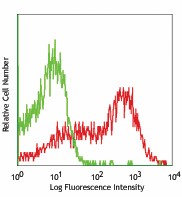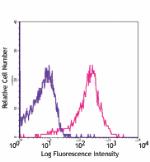- Clone
- 1A29 (See other available formats)
- Regulatory Status
- RUO
- Other Names
- ICAM-1
- Isotype
- Mouse IgG1, κ
- Ave. Rating
- Submit a Review
- Product Citations
- publications

-

LOU rat splenocytes stained with biotinylated 1A29, followed by SAV-PE
| Cat # | Size | Price | Quantity Check Availability | Save | ||
|---|---|---|---|---|---|---|
| 202403 | 100 µg | 153 CHF | ||||
CD54 is an 85 kD protein also known as ICAM-1. It is a member of the immunoglobulin superfamily that is expressed on high endothelial venules in lymphoid tissue, peripheral blood monocytes, dendritic cells, granulocytes and thymic stromal cells. CD54 is weakly expressed on T and B cells, although expression can be increased by activation (especially on endothelial cells). ICAM-1 is an important protein in cell adhesion, inflammation and immune responses. CD54 has been shown to bind to CD11a/CD18 (LFA-1), CD11b/CD18, CD11c/CD18, CD43, fibrinogen, and hyaluronan. The 1A29 antibody has been reported to block T cell aggregation and binding of lymphocytes to HEV-derived endothelial cells and purified ICAM-1 protein.
Product DetailsProduct Details
- Verified Reactivity
- Rat
- Antibody Type
- Monoclonal
- Host Species
- Mouse
- Immunogen
- HEV-derived cell line Ax
- Formulation
- Phosphate-buffered solution, pH 7.2, containing 0.09% sodium azide.
- Preparation
- The antibody was purified by affinity chromatography, and conjugated with biotin under optimal conditions.
- Concentration
- 0.5 mg/ml
- Storage & Handling
- The antibody solution should be stored undiluted between 2°C and 8°C. Do not freeze.
- Application
-
FC - Quality tested
- Recommended Usage
-
Each lot of this antibody is quality control tested by immunofluorescent staining with flow cytometric analysis. For flow cytometric staining, the suggested use of this reagent is ≤0.25 µg per million cells in 100 µl volume. It is recommended that the reagent be titrated for optimal performance for each application.
- Application Notes
-
Additional reported applications (for the relevant formats) include: immunohistochemistry1,5 of acetone-fixed frozen sections and STUF-treated paraffin-embedded sections, immunoprecipitation2, in vitro and in vivo blocking of PMA-induced T cell blast aggregation and adhesion to HEV-derived endothelial cells and purified ICAM-1 protein2,3,4.
-
Application References
(PubMed link indicates BioLegend citation) -
- Clark WM, et al. 1995. Mol. Chem. Neuropathol. 26:213. (IHC)
- Tamatani T, et al. 1990. Int. Immunol. 2:165. (IP)
- Tamatani T, et al. 1991. Eur. J. Immunol. 21:627.
- Willenborg DO, et al. 1996. J. Immunol. 157:1973.
- McKechnie NM, et al. 2002. IVOS 43:411. (IHC)
- Product Citations
-
- RRID
-
AB_2121900 (BioLegend Cat. No. 202403)
Antigen Details
- Structure
- Ig superfamily, 85 kD
- Distribution
-
High endothelial venules in lymphoid tissues, peripheral blood monocytes, dendritic cells, granulocytes, thymic stromal cells and weakly on T and B cells. Upregulated on activated cells and endothelial cells.
- Function
- Cellular adhesion, inflammation, immune reactions
- Ligand/Receptor
- CD11a/CD18 (LFA-1), CD11b/CD18, CD11c/CD18, CD43, fibrinogen, hyaluronan
- Cell Type
- B cells, Dendritic cells, Endothelial cells, Granulocytes, Monocytes, T cells
- Biology Area
- Cell Adhesion, Cell Biology, Immunology, Neuroscience, Neuroscience Cell Markers, Costimulatory Molecules
- Molecular Family
- Adhesion Molecules, CD Molecules
- Antigen References
-
1. Tamatani T, et al. 1990. Int. Immunol. 2:165.
2. Tamatani T, et al. 1991. Eur. J. Immunol. 21:627.
3. Turunen JP, et al. 1993. Scand. J. Immunol. 37:282. - Gene ID
- 15894 View all products for this Gene ID
- UniProt
- View information about CD54 on UniProt.org
Related FAQs
- How many biotin molecules are per antibody structure?
- We don't routinely measure the number of biotins with our antibody products but the number of biotin molecules range from 3-6 molecules per antibody.
Other Formats
View All CD54 Reagents Request Custom Conjugation| Description | Clone | Applications |
|---|---|---|
| Biotin anti-rat CD54 | 1A29 | FC |
| PE anti-rat CD54 | 1A29 | FC |
Compare Data Across All Formats
This data display is provided for general comparisons between formats.
Your actual data may vary due to variations in samples, target cells, instruments and their settings, staining conditions, and other factors.
If you need assistance with selecting the best format contact our expert technical support team.
-
Biotin anti-rat CD54

LOU rat splenocytes stained with biotinylated 1A29, followed... -
PE anti-rat CD54

LOU rat splenocytes stained with 1A29 PE

 Login / Register
Login / Register 










Follow Us